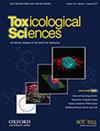雄性 Sprague-Dawley 大鼠经鼻吸入、口服和静脉注射尼古丁后尼古丁及其代谢物(可替宁和反式-3′-羟基可替宁)的药代动力学分析
IF 3.4
3区 医学
Q2 TOXICOLOGY
引用次数: 0
摘要
尼古丁是一种存在于烟草中的生物碱。人类主要通过使用烟草制品接触尼古丁。迄今为止,有关尼古丁在动物体内的药代动力学数据报道有限。本研究通过纯鼻吸入(INH)、口服(PO)和静脉注射(IV)的方式,让雄性 Sprague-Dawley 大鼠接触载体(和/或空气)或四种剂量的尼古丁。在给药后 5 分钟至 48 小时的多个时间点收集血浆、六种组织(脑、心、肺、肝、肾和肌肉)和尿液。测定了尼古丁、可替宁和反式-3′-羟基可替宁(3-OH-cotinine)的浓度,并比较了每种途径四种剂量的药代动力学特征。结果表明,单次服用尼古丁后,尼古丁的生物利用率为53%。在所有给药途径和剂量下,尼古丁都能迅速分布到所有六个组织中;肾脏中的尼古丁和可替宁含量最高,肺部中的3-OH-可替宁含量最高;尼古丁被广泛代谢为可替宁,可替宁被少量代谢为3-OH-可替宁;血浆中尼古丁、可替宁和 3-OH- 可替宁的消除遵循一阶动力学;血浆中尼古丁的半衰期比可替宁或 3-OH- 可替宁短;血浆中尼古丁、可替宁和 3-OH- 可替宁的半衰期与剂量和途径无关;尼古丁和可替宁是主要的尿排泄物,其次是 3-OH- 可替宁。血浆、组织和尿液中的尼古丁、可替宁和 3-OH- 可替宁水平呈剂量依赖性增加。这些研究结果加深了我们对尼古丁、可替宁和3-OH-可替宁不同暴露途径的药代动力学的了解。本文章由计算机程序翻译,如有差异,请以英文原文为准。
Pharmacokinetic Analysis of Nicotine and Its Metabolites (Cotinine and trans-3′-Hydroxycotinine) in Male Sprague-Dawley Rats Following Nose-Only Inhalation, Oral Gavage, and Intravenous Infusion of Nicotine
Nicotine is an alkaloid found in tobacco. Human exposure to nicotine primarily occurs through the use of tobacco products. To date, limited nicotine pharmacokinetic data in animals have been reported. This study exposed male Sprague-Dawley rats to vehicle (and/or air) or four doses of nicotine via nose-only inhalation (INH), oral gavage (PO), and intravenous (IV) infusion. Plasma, six tissues (brain, heart, lung, liver, kidney, and muscle), and urine were collected at multiple timepoints from 5 minutes to 48 hours post-dose. The concentrations of nicotine, cotinine, and trans-3′-hydroxycotinine (3-OH-cotinine) were determined, and the pharmacokinetic profiles were compared among the four doses for each route. The results indicated that after single nicotine dose, nicotine bioavailability was 53% via PO. Across all the administration routes and doses, nicotine was quickly distributed to all six tissues; kidney had the highest nicotine and cotinine levels, and the lung had the highest 3-OH-cotinine levels; nicotine was metabolized extensively to cotinine and cotinine was metabolized to a lesser extent to 3-OH-cotinine; the elimination of plasma nicotine, cotinine, and 3-OH-cotinine followed first-order kinetics; plasma nicotine had a shorter half-life than cotinine or 3-OH-cotinine; the half-lives of plasma nicotine, cotinine, and 3-OH-cotinine were dose- and route-independent; and nicotine and cotinine were major urinary excretions followed by 3-OH-cotinine. Nicotine, cotinine, and 3-OH-cotinine levels in plasma, tissues, and urine exhibited dose-dependent increases. These study findings improve our understanding of the pharmacokinetics of nicotine, cotinine, and 3-OH-cotinine across different routes of exposure.
求助全文
通过发布文献求助,成功后即可免费获取论文全文。
去求助
来源期刊

Toxicological Sciences
医学-毒理学
CiteScore
7.70
自引率
7.90%
发文量
118
审稿时长
1.5 months
期刊介绍:
The mission of Toxicological Sciences, the official journal of the Society of Toxicology, is to publish a broad spectrum of impactful research in the field of toxicology.
The primary focus of Toxicological Sciences is on original research articles. The journal also provides expert insight via contemporary and systematic reviews, as well as forum articles and editorial content that addresses important topics in the field.
The scope of Toxicological Sciences is focused on a broad spectrum of impactful toxicological research that will advance the multidisciplinary field of toxicology ranging from basic research to model development and application, and decision making. Submissions will include diverse technologies and approaches including, but not limited to: bioinformatics and computational biology, biochemistry, exposure science, histopathology, mass spectrometry, molecular biology, population-based sciences, tissue and cell-based systems, and whole-animal studies. Integrative approaches that combine realistic exposure scenarios with impactful analyses that move the field forward are encouraged.
 求助内容:
求助内容: 应助结果提醒方式:
应助结果提醒方式:


